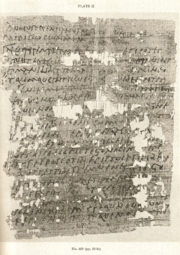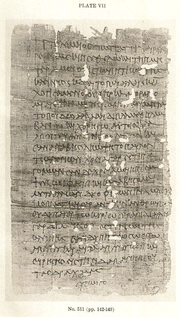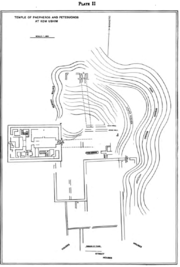
Karanis
Encyclopedia

Egypt
Egypt , officially the Arab Republic of Egypt, Arabic: , is a country mainly in North Africa, with the Sinai Peninsula forming a land bridge in Southwest Asia. Egypt is thus a transcontinental country, and a major power in Africa, the Mediterranean Basin, the Middle East and the Muslim world...
,
located in the northeast corner of the Fayum
Al Fayyum
Faiyum is a city in Middle Egypt. Located 130 km southwest of Cairo, it is the capital of the modern Faiyum Governorate. The town occupies part of the ancient site of Crocodilopolis...
.
"It was one of a number of towns established in the Arsinoite nome under Ptolemy II Philadelphus
Ptolemy II Philadelphus
Ptolemy II Philadelphus was the king of Ptolemaic Egypt from 283 BCE to 246 BCE. He was the son of the founder of the Ptolemaic kingdom Ptolemy I Soter and Berenice, and was educated by Philitas of Cos...
as part of a scheme to settle Greek mercenaries among the indigenous Egyptians and to exploit the potential fertile Fayum basin".
South Temple
The earliest archaeological origins are at the South Templeand can be traced to the 1st century BC.
It is from this point that the town expanded north when Augustus
Augustus
Augustus ;23 September 63 BC – 19 August AD 14) is considered the first emperor of the Roman Empire, which he ruled alone from 27 BC until his death in 14 AD.The dates of his rule are contemporary dates; Augustus lived under two calendars, the Roman Republican until 45 BC, and the Julian...
,
having conquered Egypt
Egypt
Egypt , officially the Arab Republic of Egypt, Arabic: , is a country mainly in North Africa, with the Sinai Peninsula forming a land bridge in Southwest Asia. Egypt is thus a transcontinental country, and a major power in Africa, the Mediterranean Basin, the Middle East and the Muslim world...
and also recognizing the Fayum’s agricultural potential,
sent workers to clean up the canals and restore the dikes that had fallen into decline, restoring productivity to the area.
A Roman-style temple was then built on top of the foundations of the old temple
at the beginning of the 1st century AD.
During this period of rebuilding, a smaller, more Egyptian-style North Temple was also built.
The South Temple was dedicated to the local crocodile gods, Pnepheros and Petesouchos,
but there is no clear dedication in the North Temple.
Conditions in the Town
The Fayum towns were settled by Roman veterans after Augustus conquered Egypt,though the small number of Latin papyri found in Karanis (only two)
and the overwhelming number of Greek papyri from or concerning these veterans from this period
suggest that these new soldiers may not have been culturally Roman but instead Greek,
or at the very least from the Eastern empire.
"The peace and political stability brought by Augustus and kept alive by his successors,
meant prosperity for generations of landholders at Karanis well into the second century AD.
In the late second century, and again in the second quarter of the third,
there were notable recessions that mirrored difficulties experienced by the Empire at large”,
houses had fallen down by the end of the 3rd century,
and the town was completely abandoned by the early 5th century.
The dry conditions that Karanis was left in are most suitable for the preservation of papyri,
and it is for this that Karanis is most well-known by archaeologists.
Papyri


Diocletian
Diocletian |latinized]] upon his accession to Diocletian . c. 22 December 244 – 3 December 311), was a Roman Emperor from 284 to 305....
and the 370s.
Also, with Karanis being a relatively poor town, the documents and artifacts excavated "[provide] a microcosm of life as it was lived by ordinary people in Egypt under Greek and Roman rule," and provide evidence of the whole of Egypt’s relationship to the Empire of Rome
Rome
Rome is the capital of Italy and the country's largest and most populated city and comune, with over 2.7 million residents in . The city is located in the central-western portion of the Italian Peninsula, on the Tiber River within the Lazio region of Italy.Rome's history spans two and a half...
. The papyri contain mostly tax records, which is how archaeologists have determined that Karanis and its veterans were mostly poor, self-sufficient farmers who did not have much contact with other towns in the region.
Excavations
These excavations were extremely troubled to say the least. In the late 19th and early 20th centuries, farmers would “obtain permits to remove soil from the Karanis mound to use as fertilizer (sebbakhSebakh
Sebakh is an Aramaic word which translates to "dry land" in English. This term is used to described decomposed organic material that can be employed both as an agricultural fertilizer and as a fuel for fires....
)”, the organic decay making the soil very rich.

Bernard Pyne Grenfell
Bernard Pyne Grenfell was an English scientist and Egyptologist and a member of The Queen's College, Oxford.With his friend and colleague, Arthur Surridge Hunt, he took part in the archaeological dig of Oxyrhynchus and discovered many ancient manuscripts known as the Oxyrhynchus Papyri, including...
and Arthur Surridge Hunt
Arthur Hunt
Arthur Surridge Hunt was an English papyrologist.Hunt was born in Romford, Essex, England. Over the course of many years, Hunt, along with Bernard Grenfell, recovered many papyri from excavation sites in Egypt, including the Oxyrhynchus Papyri.-Publications:*B. P. Grenfell, A. S...
, though they felt the area had been too plundered to produce anything of much value. At this time, archaeology as a pursuit of knowledge was wholly unheard of, and papyri and other artifacts were treated more as items to collect. Also during this time (i.e., the late 19th and early 20th centuries), excavators were almost solely interested in artifacts dating to the older dynasties, and Graeco-Roman sites such as Karanis continued to be plundered for sebbakh until Francis W. Kelsey, a professor of Latin language and literature at the University of Michigan, observed this devastation and received grants to search for an excavation site in 1924. Starting excavations of Karanis in 1925,
his goal was to "increase exact knowledge rather than the amassing of collections", with a focus on common people. The papyri collected are now part of the University of Michigan Papyrus Collection
University of Michigan Papyrus Collection
The Papyrology Collection of the University of Michigan Library is an internationally respected collection of ancient papyrus and a center for research on ancient culture, language, and history...
. More recent excavations have been done by the Cairo University, the French Institute, and for the last few years by a combined collaboration of UCLA and the University of Groningen (RUG) in the Netherlands.

